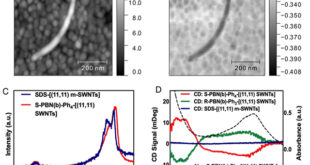Novel composite to simultaneously detect and remove heavy metals from water
Significance
The increasing release of toxic substances such as heavy metals into water resources poses a great danger to both human and aquatic life. Developing effective technologies for detection and removal of these substances from the environment has been deemed a promising approach to eliminate them. With the extensive exploration of the migration of heavy metals, presently available technologies do not simultaneous detect and remove these substances, a key issue that requires a solution. Adsorption is a widely used technology for environmental pollution mitigation due to its simplicity and cost-effectiveness. Consequently, organic chromogenic agents exhibit the ability to bind with heavy metal ions to form complex colors that can be used in their detection.
To this note, Professor Hualin Jiang, Weibo Zhang, Professor Pinghua Chen, Dr. Weiwei Zhang , Guoyao Wang, Professor Xubiao Luo, and Professor Shenglian Luo from Nanchang Hangkong University design a novel composite for simultaneous detection and removal of heavy metals. The composite comprised of two functional aspects, a classical adsorbent for high adsorption capacity and chromogenic agent for producing particular color upon absorption of a particular metal ion. Specifically, copper and ferrous ions were used to investigate heavy metal detection and removal properties of the synthesized composite. The work is currently published in the Journal of Materials Chemistry.
Unlike traditional adsorbents, the presented adsorbent is smarter in the sense that apart from high adsorption capacity, it indicates the nature and concentration of the adsorbates through color changes. The composite was effectively used to recover copper and ferrous ions from water. It became green when adsorbing copper ions and red for ferrous ions. Additionally, the composite color changed linearly with changes in the amounts of the adsorbate. This is helpful in adsorbate quantification. These color changes can be clearly detected by naked eyes or by using a photometer. The effects of various factors: pH, coexisting metal ions, initial metal concentration, and contact time on the adsorbent performance were investigated using batch sorption experiments. Based on the results, the adsorption process was observed to conform to the Langmuir model. On the other hand, the pseudo-second-order kinetic model was used to effectively describe the kinetic data.
The study presents a novel adsorbent comprising of an indicator for simultaneous detection and removal of heavy metals. The simple design and operation make it more convenient and intuitive for practical applications. Additionally, the optical response of the composite can be detected by naked eyes or cheap photometers. This kind of smart adsorbents can be developed from traditional adsorbents. As such, the highlighted method, as stated by Professor Hualin Jiang, will provide a new approach for the development of smart adsorbents for niche applications such as automatic detection and capturing machines for heavy metal contaminants.
Reference
Jiang, H., Zhang, W., Chen, P., Zhang, W., Wang, G., Luo, X., & Luo, S. (2016). Equipping an adsorbent with an indicator: a novel composite to simultaneously detect and remove heavy metals from water. Journal of Materials Chemistry A, 4(30), 11897-11907.
 Advances in Engineering Advances in Engineering features breaking research judged by Advances in Engineering advisory team to be of key importance in the Engineering field. Papers are selected from over 10,000 published each week from most peer reviewed journals.
Advances in Engineering Advances in Engineering features breaking research judged by Advances in Engineering advisory team to be of key importance in the Engineering field. Papers are selected from over 10,000 published each week from most peer reviewed journals.

